
Water Softener
A3 is a leading brand in the field of Water Softeners. This water softening Plants are based on the proven ion exchange process. The Water Softeners are simple in operation, highly efficient and compact units designed to produce soft water efficiently and economically. The Water Softeners are available in different sizes and materials, manually operated or fully Automatic, & ready to install. The Water Softening Plants are available as standard models or custom built versions for specific needs. Water Softening Plants - Operating Principle The Water Softeners are charged with a high capacity polystyrene bead cation exchange resin in sodium form. When hard water passes through this resin column, the hardness forming calcium and magnesium salts are replaced with sodium salts which do not posses any hardness properties. This softening process is continuous until the material is exhausted of sodium salts when it is regenerated with a solution of common salt. The Water Softener units are designed on the advanced Co current/counter-current principle that ensures consistent good quality treated water. A typical water softening Plant consists of pre-filters, Water Softener Vessel with Resin, Brine Tank, and accessories. The Water Softener units are available in a wide range of materials like FRP / LDPE / MS /MS Rubber Lined / Stainless Steel. These Water Softeners come with Multiport Valves/ Diaphragm Valves and designed to give long trouble free service. These Water Softener units are easy to install and does not require any special foundation & needs minimum maintenance. Automatic Twin Water Softening Plant A3 offers fully automatic twin Softeners with salt saving technology for producing soft water with low residual hardness. These softeners consume almost 25 % less salt thus saving on the Regeneration costs. Water Softening Plants - Lime softening The Lime Softening Process utilizes the addition of lime (calcium hydroxide) to remove hardness (calcium and magnesium) ions by precipitation. Softening is achieved by adding lime in the form of Ca(OH)2, which reacts first with CO2 to form calcium carbonate precipitate, and then reacts with multivalent cations to remove carbonate hardness, then reacts with anions to replace the non-carbonate hardness due to multivalent cations with non-carbonate hardness due to calcium. Lime softening process produces large volumes of sludge and as such is not used nowadays. We offer widest Range of Water Softening Plants in India: FRP Water Softeners up to 2000 mm DiameterMS Water Softeners up to 3000 mm DiameterMS Rubber lined Water Softeners up to 4000 mm Diameter Water Softener -Advantages Easy to install and operateProduces soft , non-scale forming waterHigh capacity Cation exchange resin.Consistent treated water qualityLow operating costsFully Automatic Rapid Flow Two Bed DM Plants Water Softener - Applications Water Softening Plants for Boiler feed waterWater Softening Systems for Cooling water make-upWater Softening Plants for Food and beveragesWater Softening Plants for Hotels and restaurantsWater Softeners for Air conditioning plantsWater Softeners for Laundries
...more
Water Cooler with RO Systems
Now enjoy cold drinking water that is 100% pure too! With over seven years of experience, A3 has always been at the forefront of innovation and R&D, bringing you cutting edge products and solutions that offer you more. Reverse Osmosis (RO) uses a semi-permeable membrane to filter out impurities from the water, making it safe to drink. Besides the RO filter, this range of unique Water Coolers offers a further range of 6 more filters that make the water safe to drink, both chemically and microbiologically. The filtration process lower the hardness level of the water as well as the levels of Totally Dissolved Salts. It also reduces the levels of arsenic, lead and mercury, which are dangerous heavy metal contaminants in many water sources. The filtration process also eliminates pathogenic microorganisms. All of these ensure that the water you drink is totally pure, tasty, clean and safe. UNIQUE 7-STAGE PURIFICATION PROCESS 1. Unique polypropylene yarn candle to remove physical impurities from input water2. Specially treated pre-carbon block for absorbing color, organic impurities and chlorine3. Anti-scalant filters to prevent deposits over the RO membrane4. The sediment filter traps all the fine sediments present in the input water5. RO membrane filter (porosity of 0.0001 micron) strains microorganisms and TDS from the input water6. Post-carbon filter to enhance the taste of purified water7. Nano-silver leaching effectively prevents microbial contamination in the storage tank water cooler with ROCall centressofware companiesmedium factoriesprocessing plantsmanufacturing sitesconstruction sitesclubsrailways platformcorporate buildingscommercial buildingMulti spoeciality hospitals
...more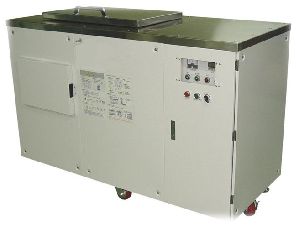
Waste Management System
Organic Waste Converter (OWC) provides sustainable solution for organic waste management at source of generation i.e. in Decentralised Waste Management. Organic Waste Converter is an indigenous technology with certified patent as AN APPARATUS AND PROCESS FOR CONVERSION OF BIOMASS / WASTE INTO BIO-ORGANIC SOIL ENRICHER & CONDITIONER AND FUEL. it converts organic waste into odour free homogenized raw compist in just 15 minutes. After one simple step of Curing for 10 days. this end product can be used as compost waste by 40-60%. organic Waste Converter can treat 100-2500 kg / day of organic waste. With few more accessories it is capable to treat 5-20 MT / day.
...more
Vechical Mounted RO Systems
A3 Techno Crafts brings to you mobile reverse osmosis system and plant to anticipate emergency crises of water purification. These systems are designed to fit into a container, mounted on a truck and can be sent anywhere for immediate use. Emergencies, Disasters, planned maintenanceand rallies are some of the areas, where mobile reverse osmosis water treatment system plays crucial role. In addition, this mobile units is also beneficial in remote village areas and military and paramilitary operations, where immediate water treatment is a prime requisite.. Features & Advantages Up to 5000 LPH capacities Unit can be configured as needed Skid-mounted fit into container Immediate start-up and use Mobile unit mounted on truck No use of chemicals Can be operated with diesel generator & solar power Perfect for emergency & military operations
...more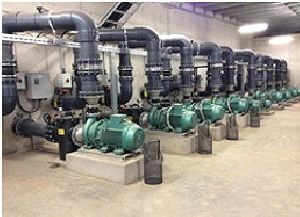
Ultrasonic Flowmeters
Ultrasonic flowmeters use sound waves to determine the velocity of a fluid flowing in a pipe. At no flow conditions, the frequencies of an ultrasonic wave transmitted into a pipe and its reflections from the fluid are the same. Under flowing conditions, the frequency of the reflected wave is different due to the Doppler effect. When the fluid moves faster, the frequency shift increases linearly. The transmitter processes signals from the transmitted wave and its reflections to determine the flow rate. Transit time ultrasonic flowmeters send and receive ultrasonic waves between transducers in both the upstream and downstream directions in the pipe. At no flow conditions, it takes the same time to travel upstream and downstream between the transducers. Under flowing conditions, the upstream wave will travel slower and take more time than the (faster) downstream wave. When the fluid moves faster, the difference between the upstream and downstream times increases. The transmitter processes upstream and downstream times to determine the flow rate. They represent about 12% of all flowmeters sold. Plusses and Minuses This technology can be very accurate and is used for custody transfer (meaning accounting accurately for an expensive fluid) of natural gas and petroleum liquids. High turndown (can read low as a percentage of the full scale or top reading), handles high pressures, is repeatable (consistent), handles extreme temperatures, can be used clamped to the outside of a pipe without penetration, is low maintenance, highly reliable and self –diagnosing. Disadvantages can include high cost, sensitivity to stray process vibrations, problems with pipe diameter change due to buildup and clamp-on units have lower accuracy. Ultrasonic flowmeters do not obstruct flow so they can be applied to sanitary, corrosive and abrasive liquids. Some ultrasonic flowmeters use clamp-on transducers that can be mounted external to the pipe and do not have any wetted parts. Temporary flow measurements can be made using portable ultrasonic flowmeters with clamp-on transducers. Clamp-on transducers are especially useful when piping cannot be disturbed, such as in power and nuclear industry applications. In addition, clamp-on transducers can be used to measure flow without regard to materials of construction, corrosion, and abrasion issues. However attractive, the use of clamp-on transducers introduces additional ultrasonic interfaces that can affect the reliability and performance of these flowmeters. In particular, if not properly applied and maintained, attenuation of the ultrasonic signal can occur at the interfaces between the clamp-on transducers and the outside pipe walls, and between the inside pipe walls and the fluid Ultrasonic flowmeters are available in sizes to 72 inches and larger.
...more
TURBIDITY METER
Turbidity Meter Specifications: Unit of Measure: 2020we: NTU, AU, ASBC, EBC 2020wi: FNU, FAU, ASBC, EBCRange:* 0-4000 NTU/FNU, 0-10,500 ASBC, 0-150 EBCResolution:* 0.01 NTU/FNU 10.00-10.99 0.1 NTU/FNU 11.00-109.9 1 NTU/FNU 110-4000Accuracy:* From 0-2.5 NTU the accuracy is ±0.05 NTU From 2.5-100 NTU the accuracy is ±2% From 100 NTU the accuracy is ±3%Detection Limit: 0.05 NTU/FNURange Selection: AutomaticReproducibility:* 0.02 NTU/FNU or 1%Light Source: Tungsten (EPA) complies with EPA 180.1 Standard 860 LED (ISO) complies with ISO 7027
...more
Sound Level Meter
A sound level meter is a measuring instrument used to assess noise or sound levels by measuring sound pressure. Often referred to as a sound pressure level (SPL) meter, decibel (dB) meter, noise meter or noise dosimeter, a sound level meter uses a microphone to capture sound. The sound is then evaluated within the device and acoustic measurement values are displayed. The most common unit of acoustic measurement for sound is the decibel (dB); however, some sound level meter devices also determine the equivalent continuous sound level (Leq) and other acoustic parameters. With a portable sound level meter, industrial hygiene and workplace safety professionals can measure sound levels in multiple locations to ensure environmental conditions fall within recommended exposure limits (RELs). Some sound level meter devices can be permanently installed for continuous monitoring of sound levels at a work or job site.
...more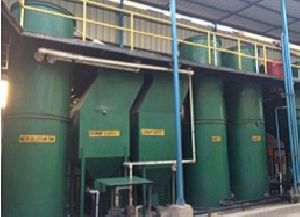
Sewage Treatment Plants
We provide Sewage Treatment Plant that are designed and manufactured using Activated Sludge Process (ASP) technology. The water treated using our plant can also be used for flushing and washing. We also design plants using other advanced technologies such as SAFF, MBBR, MBR, UASB technology and Sequential Batch Reactor (SBR). These technologies are discussed below: Submerged Aerobic Fixed Film Reactor (SAFF) is a cost-effective method of waste water treatment and sewage sanitation that is primarily used in residential and commercial complexes. This technology primarily has on the three stages that are Primary Settlement, Secondary Treatment and Final Settlement / Clarification. In the wastewater industry, SAFF Technology is seen as the simple and cost effective method of commercial and residential sewage sanitation / waste water treatment, particularly for small to medium sized treatment plants where available land is limited, and where full time operational manning would be uneconomical. A well designed Submerged Aerated Filter plant has no moving parts within its process zones, any serviceable items will be positioned to access easily without disrupting the ongoing treatment. Submerged Aerated Fixed Films (SAFF) Technology Submerged Aerated Fixed Films (SAFF) technology is a process used to reduce the organic loading of residential and commercial sewage / waste water, and in doing so will reduce the Biological Oxygen Demand (BOD) and a significant quantity of Suspended Solids (SS) which if otherwise untreated would contaminate river and sea outfalls, in other words it is used to substantially improve effluent discharge quality. As with traditional sewage treatment, Submerged Aerated Fixed Films Technology too uses three stages of dealing with commercial and residential sewage / waste water. 1. Primary Settlement: Where larger solids settle into the bottom of the primary tank and are removed periodically as sludge, and where other buoyant material which floats upwards is to be removed usually by a scraping/screening method. 2. Secondary Treatment: Where the biodegradable Organic Matter is degraded by the biomass on the SAFF media.3. Final Settlement / Clarification: Where degraded solids are settled out of the biological treated effluent. The Submerged Aerobic Fixed Film (SAFF) process uses support media to retain an active biomass to reduce the influent BOD Levels. Tubular diffusers are used with the SAFF media giving a good air dispersal and low level of blockage due to growth of biological film. SAFF reactor is a type of aerobic attached growth treatment process. Small foot print area, stable process, lesser sludge production and modular installations are the key features of SAFF process. Essentially SAFF system is a hybrid reactor where attached growth and suspended growth activity takes place simultaneously. This technology utilizes an aerobic fixed film process that is a combination submerged attached growth and activated sludge processes. Advantages : 1. No sludge re-circulation is required to maintain MLSS as in the case of conventional aeration system.2. Can be designed to any size to deal with larger flow and loads.3. Fine bubble diffused aeration used generally reduces the energy requirements as compared to surface aerators.4. Modular design allows easy installation.5. The tank does not need to be drained for access to the diffusers or media.6. SAFF system takes higher shock loads without reducing the plant performance because of large quantity of Bio mass available in the reactor.7. SAFF system takes higher shock loads without reducing the plant performance because of large quantity of Bio mass available inside the reactor.8. SAFF supports low sludge generation, low Odour and low visual impact.9. Solids Retention Time (SRT) of can vary based on influent flow without negative process impact.10. Modular expandability.11. Less susceptible to upsets due to flow variations.12. Simple, yet sophisticated.13. Maintenance requirements are simple. MBBR Sewage Treatment Plant Moving Bed Biofilm Reactor (MBBR) STP is a simple and reliable method of treating wastewater. Due to simple operations and easy manageability, it is better than the conventional methods. MBBR uses a cluster of polyethylene bio film carriers that move randomly in the aerated basin containing wastewater. Since each carrier offers an effective surface area to cater the autotrophic and heterotrophic bacteria, this system is useful for a high-density population of bacteria. High degrees of reliability and ease of operation are assured by the MBBR system. Our MBBR sewage treatment plant is ideal for removing physical, chemical and biological impurities from the wastewater produced by the kitchen, toilet or industries. We offer a world-class solution that is economical, hassle-free and multipurpose. Whether you choose MBBR treatment or Underground sewage treatment plant, it can be installed easily in a small area. It is ideal for small and medium level usage also because of lower installation, operation and maintenance costs. MBBR Based Package Sewage Treatment Plant Packaged sewage treatment plant offers a packaged, ready-to-use system, which is an integration of subsystems such as screening, aeration, equalization of the water flow, sludge digestion, and disinfection of effluent impurities. Since it is a fully assembled system, they are easy to install and use. Made from high-quality reinforced carbon steel, the package sewage treatment plant is made for long-lasting performance. We make sure that only high-strength material and the interior and exterior surfaces are coated with an industry-class epoxy coating. It makes it ideal for wastewater treatment. We have a team of experts who can offer installation and maintenance support for it. The versatile system, be it package treatment or underground sewage treatment offered by us is ideal for industries, hotels, hospitals, residential colonies, and small and medium industries. We make sure that the treated water passes quality parameters defined by authorities. Salient features: 1. Superior finish2. Rugged construction3. Easy to install4. Corrosion resistance MBBR Sewage Treatment Plant MBBR technology is a combination of attached and suspended growth technologies. Under this process, the media remains suspended in the reactor and offers additional surfaces for the microbes to grow. This in turn maximizes the growth of microbes in a given volume of aeration tank as compared to the conventional aeration without the media. The Bio-Film grows on the bio media surface and moves along with the water inside the reactor chamber creating the biomass. The efficiency of this biomass in reducing the organic load in waste water is a result of successful functioning of MBBR system. Treatment plants are upgraded to increase BOD and nutrient removal capacity from the waste water by enhancing the utilization of existing reactor's capacity. Existing activated sludge plants can be upgraded to achieve nitrogen and phosphorus removal as well. The upgrade to IFAS or MBBR often consists of simply adding carriers and screens to existing basins that upgrades the current plants in a cost-effective and timely manner without major civil engineering and land requirements. PLC based control system optimize IFAS/MBBR process performance by minimizing energy and chemical costs. By selecting innovative MBBR solutions, municipalities can cope with evolving regulation, aging infrastructure and growing population. Industrial plants can meet the strictest regulatory requirements for waste water discharge to the environment or to municipal collection systems, and address typical challenges such as variable inflow, seasonal peaks and high organic loads. SEQUENCING BATCH REACTOR (SBR) SBR is new technology for the treatment of domestic and industrial wastewaters. The SBR can treat wide range of domestic and industrial wastewaters, at flow ranging from few thousand liters to millions of liters per day. The SBR process can treat any wastewater that can be treated by activated sludge process including anoxic/oxic systems, aerated lagoons, extended aeration processes, trickling filters, rotating biological contactors (RBCS) and oxidation ditches. Like other biological effluent treatment processes SBR works by developing mixed culture of bacteria (biomass) which is effective for removal of BOD, COD and nutrients commonly found in wastewater. The SBR is true batch reactor treatment mode, which does not allow wastewater to enter the reactor during react, settle decant phases. SBR has unique ability to acts as equalization tank, aeration tank and clarifier within single reactor. For large quantities of wastewater flow (more than 500 cubic meters /day) two or more reactors are utilize in predetermined sequence of operation. Each reactor maintains its own treatment regime and all phases of treatment occur in each reactor. Feathers of SBR can be explain as follows- Tolerate variable hydraulic loads - Mixed liquor suspended solids cannot be washed away by hydraulic surge since effluent withdrawal is typically accomplished in separate phase following termination of flow to each reactor. Tolerate variable organic loads - Each influent (wastewater input) liquid batch is diluted with previous cycle reactor content. Controls filamentous growth - Filamentous microorganisms are control by creating anoxic conditions during fill phase. Provide ideal conditions for settling - Since there is no flow to the reactor during settling and no mechanical sludge collection device "stirring" provided ideal conditions for settling. Benefits of SBR - It is true reactor treatment system and able to provide consistent effluent quality to desired limits. SBR is designed to minimize operation and maintenance cost all equipment's accessible from side the plant eliminating the need to dewater. As - â�¦ Floating aeratorsâ�¦ Submersible mixersâ�¦ Effluent pumps Return Activated sludge piping is eliminated. Lower Installation costs- Maximum all operation required in effluent treatment are carried out in a single reactor it eliminates need of separate structure for each unit operation this generally result in to lower construction and installation cost. Lowest electrical operating cost- Electricity consumption per Kg BOD destroyed is around 1.1 KW as compare to other processes (1.7 KW with conventional activated sludge process). APPLICATIONS - Domestic Applications - Municipal Resorts Institutions Industrial Applications - Chemical/ Petrochemical Leachate Food Tobacco Paper & Pulp Dairy Textile OCPSF( organic chemicals, plastics ,Synthetics and Fibers)Sugar consumption per Kg BOD destroyed is around 1.1 KW as compare to other processes (1.7 KW with conventional activated sludge process). MBR STP The Membrane Bio Reactor Technology is the most advanced development in the field of biological treatment of waste water that recycles in smaller footprint and under stringent discharge norms. The MBR technology combines the skills of the membrane specialists and the biological treatment engineers to deliver integrated treatment solutions with firm process guarantees such as BOD and TSS less than 5 mg/l and also removal of nutrients (nitrogen & phosphorous), coliforms. Under this process, hollow fiber membranes are introduced to mixed liquor to separate treated effluent from mixed liquor. Membrane being the absolute physical barriers ensures complete removal of suspended impurities. MBR applications include retrofits of existing systems as well as installation of new systems, for both meeting the most stringent discharge norms and reuse. Treated waste water from MBR can be even reused for cooling tower make-up, to generate high purity water through Reverse Osmosis and other non-potable applications. This process can help environment protection by treating waste water and making it suitable for variety of application and thus conserve precious drinking water. Biological system designed for MBR process operates at higher MLVSS concentration with higher sludge retention time and thus it produces a low quantum of biological sludge which in turn reduces the sludge dewatering cost. Biological process fluid (mixed liquor) is pumped to the Membrane Operating System ("MOS"). The mixed liquor is introduced to membrane, along with air, evenly across the bottom of the tank through a unique two-phase jet system. This mixed liquor fills the membrane tank and flows upward through the membrane sub-modules, creating cross-flow dynamics across the membrane surface. This cross-flow continuously scours the membrane surface and prevents solid dehydration at the membrane surface. Applying a low-pressure vacuum to the inside of the membrane fiber pulls water through the membranes and pumps the filtered water to the next process step. Solids, including organics, bacteria, and most viruses, are rejected by the membrane system and are retained in the mixed liquor, which overflows the MOS back to the aeration tank. The Membrane Operating System is an assembly with integral membrane modules arranged in rack assemblies, inserted into the membrane tank. MOS Mixed Liquor Distribution & Recirculation Jets are designed to distribute the air scour and mixed liquor flow evenly across the membrane sub-modules. This feature eliminates potential polarization (concentration) of suspended solids around the membrane fibers which could be main cause for the failure and damage of individual fibers thus sub-modules. Additionally, this feature provides even distribution of mixed liquor solids to each membrane unit, to ensure critically that all membranes see the same process conditions. The return recirculation of mixed liquor ensures influent comes in intimate contact with the concentrated biomass, offering better organism selection and added flexibility in the anoxic cycle for advanced nitrogen removal, when required. This same jet system also acts as an integral part of the membrane cleaning system, providing an efficient scouring of the membranes with chlorine cleaning solution. The integrated cleaning system allows the sub-modules to be quickly cleaned in place. Additionally, the clean and efficient procedure eliminates the need for membrane removal from process tanks that can damage membranes and present risks to plant operators. Relaxation, Maintenance and in situ CIP are exclusive features of this MBR Process to ensure consistent water quality and complete membrane life. The entire operation is PLC controlled. The term membrane bioreactor (MBR) defines a combination of an activated sludge process and WW separation by means of membranes. The MBR process was introduced in the late 1960s, as soon as commercial scale ultra filtration (UF) and micro filtration (MF) membranes were available. The original process has combined the use of an activated sludge bioreactor with a cross flow membrane filtration loop, see Figure 1. The flat sheet membranes used in this process were polymeric and featured pore sizes ranging from 0.003 to 0.01 μm. Figure 2. Immersed Systems The breakthrough for the MBR came in 1989 with the idea to submerge the membranes in the bioreactor. Until then, MBRs were designed with the separation device located external to the reactor (side stream MBR) and relied on high trans-membrane pressure (TMP) to maintain filtration. See Figure 2, with the membrane directly immersed into the bioreactor, submerged MBR systems are usually preferred to sides stream configuration, especially for domestic wastewater treatment. The submerged configuration relies on coarse bubble aeration to produce mixing and limit fouling. In submerged configurations, aeration is considered as one of the major parameter on process performances both hydraulic and biological. Aeration maintains solids in suspension, scours the membrane surface and provides oxygen to the biomass, leading to a better biodegradability and cell synthesis. This led to a further development of MBR system. A sample configuration of a developed process is shown in figure 3a and Figure 3b shows the water circulation of three submerged modules with perspective view of the modules depicting components inside.
...more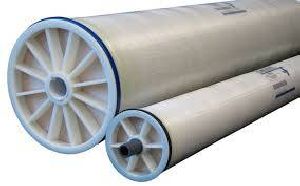
RO Membranes
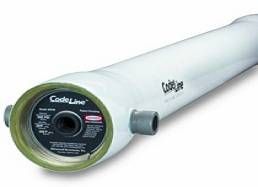
Ro Housing

Ro Controller

Pump Room Monitoring System
The condition monitoring system enables a person to view pump and process parameters via internet. The key features offered by the remote condition monitoring of pump sets are: Monitoring of operational behavior of the pump or pumping system Monitoring and analysis of faults Suggestions for tentative actions to be taken in case of faults SMS alerts and email in case of faults with daily reports through emails for record and analysis The condition monitoring system is very useful where pumps of pumping systems are catering to critical processes or applications. This is done by capturing data from pressure transmitter, flow meter, vibration sensors, bearing and winding temperatures and energy meters.
...more
Pressure Boosting Hydro Pneumatic System
Types of Systems: Constant Speed System : Tank Filling Water Transfer, Residential housing, Small size commercial, Residential buildings Cascade system (Only 1 VFD common to all pumps) : Medium size commercial, Residential buildings, Demand based industrial applications All Pump VFD system ( all pumps having their individual VFD) : Townships, Hospitals, Airports, Malls, Metros, Demand based industrial applications Offerings: Pumps: Long & Short Coupled Pumps, Single & Double Suction Pumps Vertical Inline Single & Multistage Pump Control Panel: Wall & floor mounted panels Energy Saving and Efficiency Sustainable Coatings: Glass flake coating on Pumps, Valves, Tanks, and Pipes etc. Accessories: Skid (Suction and Discharge header, NRVs, Isolating Valves, Pressure Switch/ Pressure Transmitter), Pressurised tank, Solenoid valves, Float switches Service Backup: 24x7 Service Backup, Energy Audit, O&M Contract, etc.
...more
Multistage RO system
A3 Techno Crafts Reverse usage is a technology designed to minimize concentrate (waste) water that would normally go down the drain. Reverse usage technology is a re-circulation method used to recycle wastewater back through the membranes to improve efficiency allowing for waste to product (permeate) water ratios unparalleled by other reverse osmosis systems. The ratios are adjustable and if certain feed water conditions are met due to the nature of feed water or by implementing the proper pre-treatment you can literally reverse the ratio that other RO systems offer. Instead of a 4:1 waste to product water ratio you can run an unbelievable 1:4 waste to product water ratio!Designed to produce "low total dissolved solids" water from ETP or wastewater, the A3 Techno Crafts RO maximizes high efficiency with ultra-low energy reverse osmosis membranes. The product water can be used in applications such as process requirements, agriculture, aquarium stores, breweries, spot free rinse, water stores, whole house, labs, medical, high-tech, ice makers, humidification, misting and a wide variety of other applications. A3 Techno Craftshas a complete line of professional quality, commercial water filtration products. We are the leaders in high efficiency, expandable Reverse Osmosis. Some of the benefits of using A3 Techno Crafts RO systems are: Expandable capacity – starting at 2,000 Gallons Per Day, the membrane add-on kit allows increased flow rates of up to 10,000 GPD The Mega extended frame version allows flow rates from 11,500 GPD up to 19,000 GPD Adjustable drain water ratios – run hyper efficient ratios of up to 1 part drain to 4 parts product water. Save more water! Extra Low energy Reverse Osmosis membranes with up to 99% PPM reduction.
...more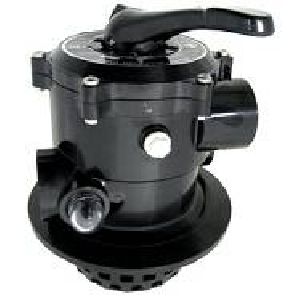
Multiport Valves

mix bed
Mixed bed de-mineralisers are used on the downstream of the DM unit to achieve high purity levels in the treated water. We confer packaged and custom-built mixed bed de-mineralisers. These mixed bed units comprise of a single vessel with a mixture of cation and anion resins and are offered with complete service and regeneration piping, self supportive skid foundation and chemical tanks for regeneration. We can design and build bespoke mixed bed polishing units to suit all of our customers requirements. Cation and Anion resins are combined in a GRP or stainless steel vessel to produce ultra pure water. Usually a mixed bed polishing unit contains strong acid Cation (SAC) resin and strong base Anion (SBA) resins combined to a ratio of approximately 40% Cation resin to 60% Anion resin. (All resin volumes are dependant upon the incoming water analysis and the required quantity of treated water). Mixed bed polishers are typically installed when a water quality of less than 1 micro ohm conductivity is required. we can install mixed bed polishers after a standard Reverse Osmosis or Demineraliser, to produce ultra high quality water. The Cation resins in our mixed bed polishers are of a higher specific gravity and settle at the bottom of the vessel whilst the Anion resin will automatically float to the top. Please note: The Cation resin must be a strong acid Cation type (SAC) and the Anion resin must be a strong base Anion resin (SBA) After a service cycle, each resin is regenerated as listed: (SAC) : Strong Acid Cation resin is washed with approx. 30% hydrochloric acid. Please note: The above regenerate strengths refer to the values before being diluted by the mixed bed polisher educator systems.
...more
LPH RO System
RO Water Treatment Plants for in house production of drinking water/ Reuse in Process: We are engaged in offering Water Treatment Plants that are based on Reverse Osmosis, Ultra Filtration, NANO Filtration technology. In this technology, reverse osmosis takes place with high pressure and because of this, the flow of water gets reversed through the semi-permeable membrane. This assists us in clearing the water from excess salts using the high pressure produce in the RO module. The extra salts are stored in the module and permeate blends with the filtered water to get the needed TDS. To remove the elements that may block the membranes, the feed water is pre-treated. The filtration of the water depends on the pressure, concentration of salts and the salt that gets filtered through the membrane Understanding Reverse Osmosis Reverse Osmosis, commonly referred to as RO, is a process where you demineralize or deionize water by pushing it under pressure through a semi-permeable Reverse Osmosis Membrane. Osmosis To understand the purpose and process of Reverse Osmosis you must first understand the naturally occurring process of Osmosis. Osmosis is a naturally occurring phenomenon and one of the most important processes in nature. It is a process where a weaker saline solution will tend to migrate to a strong saline solution. Examples of osmosis are when plant roots absorb water from the soil and our kidneys absorb water from our blood. Below is a diagram which shows how osmosis works. A solution that is less concentrated will have a natural tendency to migrate to a solution with a higher concentration. For example, if you had a container full of water with a low salt concentration and another container full of water with a high salt concentration and they were separated by a semi-permeable membrane, then the water with the lower salt concentration would begin to migrate towards the water container with the higher salt concentration. A semi-permeable membrane is a membrane that will allow some atoms or molecules to pass but not others. A simple example is a screen door. It allows air molecules to pass through but not pests or anything larger than the holes in the screen door. Another example is Gore-tex clothing fabric that contains an extremely thin plastic film into which billions of small pores have been cut. The pores are big enough to let water vapor through, but small enough to prevent liquid water from passing. Reverse Osmosis is the process of Osmosis in reverse. Whereas Osmosis occurs naturally without energy required, to reverse the process of osmosis you need to apply energy to the more saline solution. A reverse osmosis membrane is a semi-permeable membrane that allows the passage of water molecules but not the majority of dissolved salts, organics, bacteria and pyrogens. However, you need to 'push' the water through the reverse osmosis membrane by applying pressure that is greater than the naturally occurring osmotic pressure in order to desalinate (demineralize or deionize) water in the process, allowing pure water through while holding back a majority of contaminants. Below is a diagram outlining the process of Reverse Osmosis. When pressure is applied to the concentrated solution, the water molecules are forced through the semi-permeable membrane and the contaminants are not allowed through. Reverse Osmosis works by using a high pressure pump to increase the pressure on the salt side of the RO and force the water across the semi-permeable RO membrane, leaving almost all (around 95% to 99%) of dissolved salts behind in the reject stream. The amount of pressure required depends on the salt concentration of the feed water. The more concentrated the feed water, the more pressure is required to overcome the osmotic pressure. The desalinated water that is demineralized or deionized, is called permeate (or product) water. The water stream that carries the concentrated contaminants that did not pass through the RO membrane is called the reject (or concentrate) stream. As the feed water enters the RO membrane under pressure (enough pressure to overcome osmotic pressure) the water molecules pass through the semi-permeable membrane and the salts and other contaminants are not allowed to pass and are discharged through the reject stream (also known as the concentrate or brine stream), which goes to drain or can be fed back into the feed water supply in some circumstances to be recycled through the RO system to save water. The water that makes it through the RO membrane is called permeate or product water and usually has around 95% to 99% of the dissolved salts removed from it. It is important to understand that an RO system employs cross filtration rather than standard filtration where the contaminants are collected within the filter media. With cross filtration, the solution passes through the filter, or crosses the filter, with two outlets: the filtered water goes one way and the contaminated water goes another way. To avoid build up of contaminants, cross flow filtration allows water to sweep away contaminant build up and also allow enough turbulence to keep the membrane surface clean. tea coffe jointseating jointsfast food outletsgym/spascoaching centressmall officesIce cream jointsSoda water outletscollection centresdhabasclubsCanteens
...more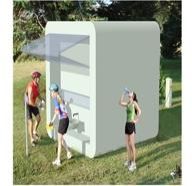
Large Capacity Drinking Water Station
In India, packaged bottle water has established a major foothold. In some cities, piped-water systems are lacking; in others, people are uncertain about biological contamination, taste, and odor. Even in the capital New Delhi, only about three fourths of the population receives piped water from the municipal authority. Outside New Delhi far fewer people have access to clean water distribution. In both locations, these families must find alternate water sources if they are to avoid epidemics and other health problems spawned by the foul, contaminated water available in their neighborhoods. A solution has appeared as Large Capacity water refilling stations that now dot the Indian landscape. These water stations began as privately run community sources, where consumers would bring containers and fill them for a per-gallon fee that is a small fraction of commercially bottled water's cost. Demand is such that most stores now offer home delivery for regular customers. Most shops produce between 3,000 and 12,000 liters of water per day. Typically, the supply comes from the pipes of municipal concessionaires. Entrepreneurs invest in treatment equipment and further purify their product before sale. The government has accepted private water shops as a necessary weapon in the fight against waterborne disease and regulates their quality control practices and final product as much as possible.
...more
Industrial Ultra Filter System
We at A3 Techno Crafts provide fully automated systems for filtration of surface or well water. Performance: 3 to 48 m3/h or 70 to 1100 m3/day plant.Ultrafiltration allows in many cases the utilization of alternative raw water instead of precious tap water. The use of surface water or ETP water therefore saves cost and protects the environment.With a wide range of optimized UF systems, we are a strong partner for you in all ultrafiltration applications.We will be happy to support you on ultrafiltration solutions and discuss potential savings and ROI based on your project data. Very short payback period, usually
...more
Cold POU RO System
Hot and Cold POU RO System Testing your water may show that it contains heavy metals like lead nitrate, lead, and copper, as well as viruses and even bacteria. This can be scary. These pollutants can cause serious health problems. In order to protect against health problems a good solution is to make an investment in a cold hot water dispenser. It allows you to have fresh purified water at any time. Moreover, these coolers also provide point of use cup dispensers. Choosing the Right System When choosing a water dispenser, keep in mind that there are several different styles, some are just coolers, while others offer hot and normal water as well. There are also different types of filters from your basic charcoal to the highest quality reverse osmosis. For most systems, the basic carbon and sediment filters provide adequate quality for removing the chlorine and other undesirable contaminants. If you are concerned with heavy metals, then an RO water filtration system will be a better choice. Several companies have different types of water filtration systems and different methods used to cool the unit. Thermoelectric modules are a source of energy that is economical, quiet, environmentally friendly and trustworthy. If the environment is maintained at about 30 degrees, it is preferable to use compressor technology, since it performs a high cooling capacity. Your water service specialist can provide the best option for you. Water Coolers for offices The workplace is the place where cold and hot water dispensers are used, as today many people desire the same quality in their homes. Organizations are concerned about the impurities in Bottle water and want to make sure they have filtered water going to their staff. You can choose to locate your system and route the feeder to other devices, like a coffee maker or refrigerator. In an office environment, some units are better suited to an office with more than five employees, while others are enough for use by the members of one family with one of the smaller volume units. Choosing the Right Temperatures Some units have faucets for hot and cold water. The hot water is ideal for a small glass of instant coffee or hot chocolate. Staff often prefers a unit, including a safety switch, and keeping it a safe distance to avoid burns.Once you determine your basic needs, Your water cooler dispenser provider will ensure that your unit is installed correctly and provide and ongoing service that your may require.
...more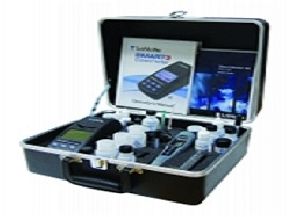
Hardness Testing Kit
This Kit has instrumentation and reagent systems to provide a preliminary screening of stormwater outflow, and to determine whether it is contributing to the overall pollutant load from precipitation events. Meets guidance as set forth by USEPA. Features Fast Most tests can be completed in under 2-minutes Easy All meters and tests come with easy-to-follow instructions Unique Design All-in-one kit covers your testing needs in one carrying case Expandable To over 80 tests.
...more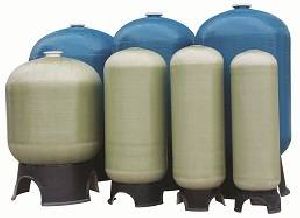
Frp Vessels

Filter Cartridges

Electro Chlorination System
Be first to Rate
Rate ThisOpening Hours